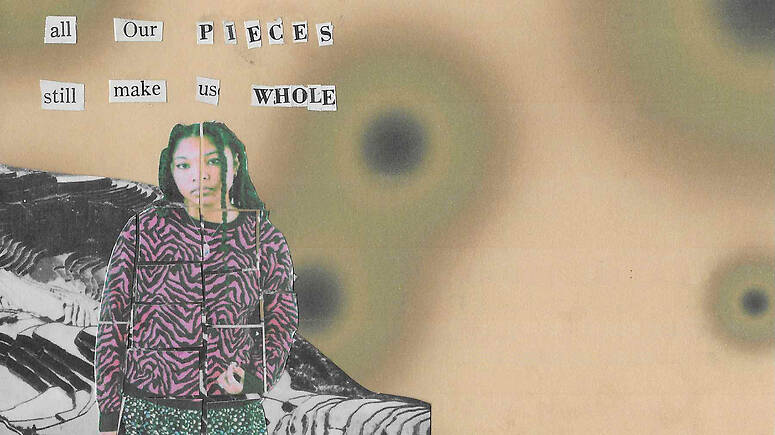
Pierless Bridges
The Joan and Ralph Lane Center for Catholic Social Thought and the Ignatian Tradition
A Reflection on Healing, Anti-Black Racism, and Cura Personalis
Are you sure, sweetheart, that you want to be well?... Just so’s you’re sure, sweetheart, and ready to be healed, cause wholeness is no trifling matter. A lot of weight when you’re well.
—Toni Cade Bambara, The Salt Eaters
As we mark the one-year anniversary of COVID-19’s deadly emergence and the murder of Breonna Taylor, I’ve been reflecting on this passage from The Salt Eaters and its implications both at the personal and societal level. I’ve been asking, what must we take up and what must we let go as we fight against anti-Black racism and toward racial equity? How do we let go of the pain and hurt or perhaps, the unearned privilege and resources to allow wholeness and racial justice to come in? How do we move forward when we know enough to say that we need to be healed but don’t yet want to do the heavy work required nor have a clear vision of what it means to be healthy?
This question of “being well” animates much of my research. As a scholar, I investigate what it means for Black women and girls to live full, meaningful lives; how existing societal structures and processes facilitate and/or hinder this process; and what Black women and those in power (not always mutually exclusive) can and should do about it. In this essay, I ask, “How can the academy move beyond declarative anti-racist statements and do the heavy lifting required to uproot the racist structures that sit at the foundation of our institutions?” To examine this problem, I engage an intersectional Black feminist perspective to offer a partial yet crucial perspective on how anti-Black racism takes gendered forms and subsequently maintains labor inequities within the academy. I then explore cura personalis and its potential as an intersectional, anti-racist praxis that, if implemented at the institutional level, can recognize the humanity of Black people and serve as a vehicle to transform the University.
For the past six months, I have had the privilege of building community with three Black female identified faculty. During our monthly check-ins, we share our personal and professional triumphs, fears, and dreams. In particular, we discuss the challenges of teaching at a predominately white institution (PWI). Unfortunately, many of our experiences confirm the literature which finds that Black faculty at PWIs experience “a hostile climate and unwelcoming colleagues, students who challenge their authority in the classroom and question their expertise on teaching evaluations, lower levels of scholarly productivity given the more intense service loads, and difficulty publishing work that may be perceived as “unconventional” for the field” (Flaherty, 2020; see also Griffin, 2020).
Moreover, as Black women, we often find ourselves navigating the specter of “the strong Black woman,” or the SBW. Characterized by strength, self-sacrifice, caretaking, and the ability to endure hardship and overcome it, the SBW trope has been used by the Black community to combat the negative stereotypes of Black women as complicit mammies, hypersexual jezebels, or ratchet sapphires (Wallace, 1979; Harris-Perry, 2011). But the SBW harms Black women. It creates the illusion that mulelike labor and “making a way out of no way” are who we are and desire to be as Black women, rather than an adaption to, and a figment of the racist and sexist structures that demand this strength to survive (Hill-Collins, 2005). Thus the trope’s true function is to obscure our labor exploitation and uphold the existing power structure (Beauboeuf-Lafontant, 2007). For example, within the academy, the SBW trope hides the excessive emotional and administrative labor Black women are asked to do in the name of service and then punishes us for the negative impact this can have on our academic careers. This insight about the SBW trope and its accompanying extractive and harmful labor practices in the academy is not new (Huddleston Mattai, 1995; Woods-Giscombé, 2010). What is of interest to me and that became apparent across our conversations is how the SBW intersects with and problematizes the Jesuit value of cura personalis. Black women’s experiences in the academy open the door to questioning whose care is valued and what work may be required to have our anti-racism statements and practice of cura personalis match.
Over the past year, Jesuit colleges and universities, as well as the Jesuit order, have attempted to address their participation in the purchase and selling of Black bodies, past segregation policies, and current practices and policies that maintain a culture wherein Black people are marginalized and targets of racial bias, hate crimes, and other forms of symbolic and systemic oppression. To address these longstanding issues, Jesuits often draw upon one of their cornerstone values, cura personalis. Cura personalis, or care for the whole person, is articulated and understood as an interpersonal relationship between the University and its students and professes a “respect for each person’s intellectual, physical, and spiritual health and autonomy.”1 When cura personalis is used as a framework to guide our anti-racism efforts, we often create workshops, dialogues, training modules, and healing spaces. These are important! That said, this type of programming while necessary, fails to address the structural inequalities at the root of anti-Black racism and also often relies upon Black faculty/staff and key allies to perform the emotional and administrative labor required to support these efforts. Yet, while Black students comprise 14 percent of admitted college students nationally and 6 percent at USF, Black full-time faculty make up only 5.5 percent nationally and 4 percent at our institution.2 Moreover, when we examine the offices and structures in place at our universities that house much of the Diversity, Equity, Inclusion, and Belonging (DEIB) work, a pattern emerges. For example, how fully funded and staffed are our Critical Diversity Studies/Ethnic Studies programs, our diversity pipeline hiring initiatives, our programs that target the recruitment and retention of students of color, Black History Month programming, our DEIB office, and initiatives? If these programs and offices are not fully resourced, our anti-racist declarations and commitment to cura personalis ring hollow, not just for our students but also for those who are tasked with carrying out our DEIB efforts.
Instead, we need to reimagine cura personalis as an intersectional, anti-racist institutional praxis that sits at the center of our educational enterprise and extends to every community member. According to Bninski & Wozniak-Boyle (May 2020), a shift from the interpersonal to the institutional is necessary because institutional practices shape interpersonal practices, and the current interpersonal model is limited because it “reinforces gendered and racialized expectations of emotional availability and labor” (124). Institutionalizing cura personalis, they argue, can provide holistic services and design work conditions that encourage the modeling and formation of healthy interpersonal relationships. I agree and suggest that we must intentionally and explicitly imbue cura personalis with an anti-racist intersectional praxis. Failure to do so will maintain the existing, albeit often invisible, intersectional institutional position that is tied to the experiences of white cisgendered, able-bodied men. Becoming an anti-racist institution necessitates acknowledging and shifting this center of power. From here, we can engage the hearts and minds of all community members through discernment and dialogue, and engage our collective will to transform the structures and embodied positionalities upon which our universities rest.
TO BEGIN THIS PROCESS, THE ENTIRE UNIVERSITY COMMUNITY MUST ENGAGE IN INTERSECTIONAL ANTI-RACISM WORK AS A SYSTEM, NOT JUST DELEGATE IT TO BIPOC FACULTY/STAFF AND KEY ALLIES.
To fully commit to this process, we must reprioritize and reallocate, if necessary, resources from other areas to fully fund DEIB work at our institutions. Such funding will allow us to fully enact our values by maintaining and growing support for our students; hiring Black faculty; fully funding and staffing Critical Diversity or Ethnic Studies programs; instituting or revising the cultural diversity core so that it teaches all of our students about structures of power, privilege, and inequality in the US and globally; making diversity work a part of every employee’s program review; implementing an equity tool that all employees can use when decisions are being made; respectfully and effectively managing bias incidents; reimagining public safety on our campus; and publicly monitoring our progress. Changing how we allocate funding and resources and how we imagine policies and processes can reposition all marginalized groups so that cura personalis can be realized for every member of our community.
Tragedy has a way of calling us to action. However, our anti-racist praxis cannot only be declared after tragedies to be defunded after the vigils, outrage, and protests subside. What separates Jesuit colleges and universities from publicly funded and other private institutions is our moral imperative. We are compelled to do what is right, not because it is marketable, not because it is financially expedient, but because it aligns with God’s purpose. Cura personalis call us to discern, dialogue, and then engage in an anti-racist intersectional praxis that values the dignity and well-being of all. It is not enough to simply talk about getting well. We must act and do the hard work and difficult work of creating a socially just world.
References
- "Cura Personalis"
- "Facts & Statistics," "Fast Facts" and "Facts & Statistics."
- Bambara, T.C. (1980). The Salt Eaters. Random House.
- Beauboeuf-Lafontant, T. (Feb. 2007). You Have to Show Strength: An Exploration of Gender, Race, and Depression. Gender & Society, 21(1), 28–51.
- Bninski, J., & Wozniak Boyle, J. R. (May 2020). "Cura Personalis as Institutional Practice." Jesuit Higher Education: A Journal, 9(1).
- Flaherty, C. (Oct. 2020). The Souls of Black Professors. Inside Higher Education.
- Griffin, K. (2020). "Institutional Barriers, Strategies, and Benefits to Increasing the Representation of Women and Men of Color in the Professoriate." In L. Perna (Ed.), Higher Education: Handbook of Theory and Research, vol 35 (1–73). Springer Cham.
- Harris-Perry, M. (2011). Sister Citizen: Shame, Stereotypes, and Black Women in America. Yale University Press.
- Hill Collins, P. (2005). Black Sexual Politics: African Americans, Gender, and the New Racism. Routledge.
- Huddleston-Mattai, B. (1995). "The Black Female Academician and the 'Superwoman Syndrome.'" Race, Gender and Class, vol. 3, No. 1, 49–64.
National Center for Education. (n.d.). Fast Facts: Enrollment. - National Center for Education Statistics. (n.d.) Fast Facts: Race/Ethnicity of College Faculty.
- University of San Francisco (2021). About USF / What you need to know / Facts & Statistics.
- University of San Francisco (2021). About USF / Who we are / Our values / Cura Personalis.Wallace, M. (1979). Black Macho and the Myth of the Superwoman. Dial Press.
- Woods-Giscombé, C. L. (Feb. 2010). "Superwoman Schema: African American Women's Views on Stress, Strength, and Health." Qualitative Health Research, vol. 20, No. 5, 668–683.



